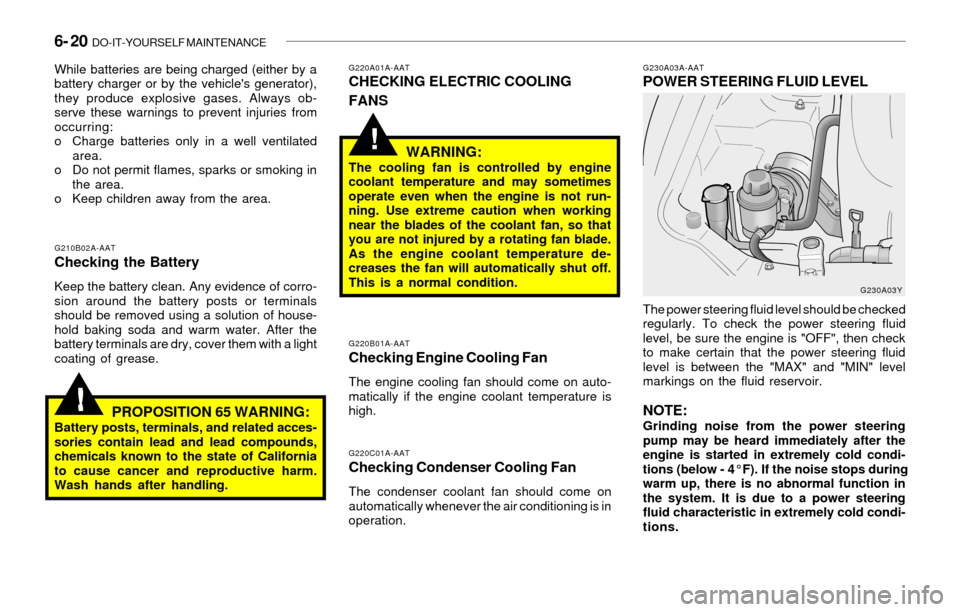2003 Hyundai Sonata Spark
[x] Cancel search: SparkPage 164 of 205

DO-IT-YOURSELF MAINTENANCE 6- 9
!
4. Turn the radiator cap counterclockwise with-
out pressing down on it, until it stops. This
relieves any pressure remaining in the cool-
ing system. And remove the radiator cap by
pushing down and turning counterclock-
wise.
Now fill the radiator with clean demineralized
or distilled water. Continue to add clean
demineralized or distilled water in small quan-
tities until the fluid level stays up in the
radiator neck.
5. Start the engine, top off the radiator with
water and then add coolant to the reservoir
until the level is between "L" and "F".
6. Replace the radiator and reservoir caps and
check to be sure the drain cocks are fully
closed and not leaking.G060A02Y-AATSPARK PLUGS
Your engine was originally equipped with plati-
num-tipped spark plugs.
Platinum-tipped spark plugs will last longer than
conventional type spark plugs and can be
identified by blue lines on the ceramic shell.
NOTE:Do not clean or regap platinum-tipped spark
plugs.
WARNING:The cooling fan is controlled by engine
coolant temperature and may sometimes
operate even when the engine is not run-
ning. Use extreme caution when working
near the blades of the coolant fan so that
you are not injured by a rotating fan blade.
As the engine coolant temperature de-
creases, the fan will automatically shut off.
This is a normal condition.
HSM392G060B04Y-AAT
Replacing the Spark PlugsThe spark plugs should be changed at the
intervals specified in the vehicle maintenance
schedule in Section 5 or whenever engine
performance indicates they should be changed.
Symptoms that suggest poor spark plug perfor-
mance include engine misfiring under load, loss
of fuel economy, poor acceleration, etc. When
spark plugs are replaced, always use spark
plugs recommended by Hyundai. The use of
other spark plugs can result in loss of perfor-
mance, radio interference or engine damage.
NOTE:When replacing the spark plugs, always use
the genuine parts recommended.
Recommended Spark Plugs:
Type
RN10PYP4 (CHAMPION)
PGR5C-11 (NGK)
RC10PYB4 (CHAMPION)
PFR5N-11 (NGK)Remark
For 2.4L only
For 2.7L only
DOHC V6
0.1~1.1 mm 0.1~1.1 mm
Page 165 of 205

6- 10 DO-IT-YOURSELF MAINTENANCE
!
G060C04Y-AATChanging the Spark Plugs
You will find it easier to change spark plugs if the
engine is cold. Always change one spark plug
at a time. This helps avoid getting the wires
mixed up.
1. Remove the center (2.4 L) cover on the
engine rocker cover.
NOTE:It is recommended that the spark plugs (For
2.7L Engines) should be changed by an
authorized Hyundai dealer.
2. Using a clean cloth, remove any dirt that has
accumulated around the base of the spark
plug so it cannot fall into the cylinder when the
spark plug is removed.3. To remove the spark plug cable, pull straight
up on the insulated connector, not the cable.
Pulling on the cable may damage the carbon
core conductor.
WARNING:It is recommended that the engine be cool
or cold when changing the spark plugs. If
the engine is hot, you could burn yourself
on the insulated connector, the spark plug
or the engine itself.
4. When preparing to remove the old spark
plug, guide the socket down over the spark
plug, being careful not to damage the ce-
ramic insulator.
5. To remove the old spark plug, turn the
wrench handle in a counterclockwise direc-
tion.6. To install the new spark plug, guide the
socket down over the spark plug, being
careful not to damage the ceramic insulator.
NOTE:Spark plugs should be tightened to speci-
fication. Over-tightening can damage the
threads in the aluminum cylinder head.
Also, leaving them too loose can cause the
spark plug to get very hot and possibly
result in damage to the engine.
7. Replace the cable by pushing the insulated
connector directly down onto the electrode.
Check to be sure it has snapped into place
and can’t fall off.
G060C01O
G060C02OG060C03O
Page 175 of 205

6- 20 DO-IT-YOURSELF MAINTENANCE
!
!
G230A03A-AATPOWER STEERING FLUID LEVEL
G220B01A-AATChecking Engine Cooling Fan
The engine cooling fan should come on auto-
matically if the engine coolant temperature is
high.
G220A01A-AATCHECKING ELECTRIC COOLING
FANS
G220C01A-AATChecking Condenser Cooling Fan
The condenser coolant fan should come on
automatically whenever the air conditioning is in
operation.
G210B02A-AATChecking the Battery
Keep the battery clean. Any evidence of corro-
sion around the battery posts or terminals
should be removed using a solution of house-
hold baking soda and warm water. After the
battery terminals are dry, cover them with a light
coating of grease. While batteries are being charged (either by a
battery charger or by the vehicle's generator),
they produce explosive gases. Always ob-
serve these warnings to prevent injuries from
occurring:
o Charge batteries only in a well ventilated
area.
o Do not permit flames, sparks or smoking in
the area.
o Keep children away from the area.
WARNING:The cooling fan is controlled by engine
coolant temperature and may sometimes
operate even when the engine is not run-
ning. Use extreme caution when working
near the blades of the coolant fan, so that
you are not injured by a rotating fan blade.
As the engine coolant temperature de-
creases the fan will automatically shut off.
This is a normal condition.
The power steering fluid level should be checked
regularly. To check the power steering fluid
level, be sure the engine is "OFF", then check
to make certain that the power steering fluid
level is between the "MAX" and "MIN" level
markings on the fluid reservoir.
NOTE:Grinding noise from the power steering
pump may be heard immediately after the
engine is started in extremely cold condi-
tions (below - 4°F). If the noise stops during
warm up, there is no abnormal function in
the system. It is due to a power steering
fluid characteristic in extremely cold condi-
tions.
G230A03Y
PROPOSITION 65 WARNING:Battery posts, terminals, and related acces-
sories contain lead and lead compounds,
chemicals known to the state of California
to cause cancer and reproductive harm.
Wash hands after handling.
!
Page 198 of 205

VEHICLE SPECIFICATIONS 9- 3
J070A03Y-AATENGINE
ITEMS
Engine Type
Bore x Stroke. in. (mm)
Displacement. cc
Firing order
Spark plugType
Gap
Oil pan capacity us.qt. (lmp.qt., liter)
Oil filter capacity us.qt. (lmp.qt., liter)
Idle speed (rpm)
Ignition timing (Base)
Oil grade (API)2.4L (DOHC)
4-Cyl., In-line DOHC
3.41x 3.94 (86.5 x 100)
2,351
1 - 3 - 4 - 2
CHAMPION : RN10PYP4
NGK : PGR5C-11
4.2 (3.5, 4.0)
0.31 (0.26, 0.3)
700 ± 100
BTDC 5° ± 2°2.7L (V6)
6-Cyl., V-type DOHC
3.41 x 2.95 (86.7 x 75.0)
2,656
1 - 2 - 3 - 4 - 5 - 6
CHAMPION : RC10PYPB4
NGK : PFR5N-11
4.4 (3.68, 4.2)
0.31 (0.26, 0.3)
700 ± 100
BTDC 12° ± 5°
SPECIFICATIONS
0.039 - 0.043 in. (1.0 - 1.1 mm)
SH, SG or SG/CD and ABOVE multigrade and fuel-efficient oil
Page 203 of 205

10- 4 INDEX
K
Key ..................................................................................................... 1-3
If you lose your keys ...................................................................3-11
Positions......................................................................................... 2-3
M
Maintenance Intervals
Explanation of scheduled maintenance items ............................... 5-7
Maintenance under severe usage conditions ............................... 5-6
Scheduled maintenance ................................................................ 5-4
Service requirements .................................................................... 5-2
Map lamp ...........................................................................................1-49
Mirrors
Day-night inside rearview ............................................................1-52
Outside rear view .........................................................................1-50
O
Odometer..........................................................................................1-39
Outside rear view mirror heater .......................................................1-51
P
Parking Brake ....................................................................................1-56
Passenger Presense Detection .......................................................1-31
Power Driver seat .............................................................................1-13
Power Outlet ......................................................................................1-61
Power Steering Fluid Level ...............................................................6-20R
Radio (H240, H260, H290) ........................................... 1-80, 1-85, 1-90
Rear Seat
Fold down .....................................................................................1-15
Rear View mirror ...............................................................................1-52
Rear Window Defroster Switch ........................................................1-44
Reporting Safety Defects ................................................................... 8-7
S
Seat
Front.............................................................................................1-10
Seat Belts
3-Point system .............................................................................1-18
Adjusting your seat belt ...............................................................1-20
Care of seat belts .........................................................................1-17
Precautions..................................................................................1-16
Shop Manual ........................................................................................ 8-5
Spark Plugs ......................................................................................... 6-9
Speedometer.....................................................................................1-38
Starting Procedure .............................................................................. 2-4
Steering Wheel
Free play ......................................................................................6-16
Steering Wheel Tilt Lever ..................................................................1-61
Stereo Radio Operation (H240, H260, H290) .............. 1-80, 1-85, 1-90
Stereo Sound System .......................................................................1-78
Sun Visor ...........................................................................................1-60
Sunroof..............................................................................................1-47